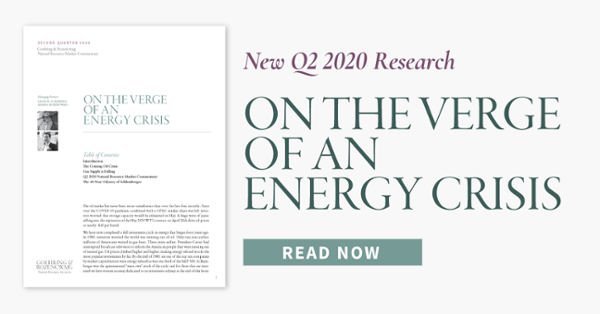By Leigh Goehring
The FANG stocks are today’s investment craze. For comparison’s sake, consider Schlumberger’s odyssey from 1962-1980. From its initial public offering on the NYSE in 1962 to its peak in 1980, Schlumberger appreciated 50-fold. Its cult status among investors was rivaled only by Radio Corporation of America during the 1920s. Adding to its mystique, Schlumberger was the only member of the Nifty Fifty growth stock craze of the late 1960s and early 1970s to emerge unscathed from the 1974-75 bear market. Unlike its peers, Schlumberger actually emerged from the carnage some five times higher. An investor that bought Schlumberger at its average price in 1962 enjoyed a 25% compounded return over the next eighteen years. Instead of slowing, by the end of the 1970s, Schlumberger’s revenue and earning’s growth were accelerating. An investor who bought the stock in 1971 compounded their money at 37% over the next nine years. An investor in the Dow Jones Industrial Average, by comparison, experienced a compounded return of only 3%. On a split-adjusted basis, Schlumberger peaked in 1980 at $19.73; forty years later (2020), the stock ended the second quarter at $18.39. The Dow Jones has rallied from 900 to 26,000 over the same period.
Market lore maintains that Schlumberger became the largest company in the world based on market capitalization in 1980, but this is not true. With nearly 191 mm shares outstanding, its $25 bn of market capitalization placed it fourth behind AT&T (pre-breakup), IBM and Exxon, each worth approximately $40 bn.
What was impressive was Schlumberger’s capitalization when adjusted for the size of its asset base. AT&T’s book value was $125 bn while Exxon and IBM had $50 and $30 bn of book value, respectively. Schlumberger, on the other hand, was almost tiny. It had only $5 bn of invested capital – between six and thirty times less than its closest market capitalization rivals.
The company provided the most advanced exploration, drilling, and production services to a global oil and gas industry that was rapidly expanding. Oil prices had started the decade at $3.50 per barrel and by 1980 had rallied more than ten-fold to surpass $35. Oil and gas producers found themselves awash in cash that needed to be reinvested.
Investors believed the world’s oil supply faced continued disruptions and production disappointments. Prices were high and were expected to move much higher. Energy company budgets exploded in response to ever-rising oil prices and this explosion in upstream capital spending directly lifted Schlumberger’s top and bottom line. Between 1970 and 1980, Schlumberger compounded its revenues by 28% per annum while its earnings grew by 36% annually. I began my investment career in the early 1980s in the trust department of a prominent Wall Street bank and vividly recall how nearly every trust and investment account held the stock.
Given its popularity, it is not surprising that Schlumberger sported an expensive valuation. At its peak in late 1980, Schlumberger was priced at 25 times its earnings and nearly eight times its book value, while its enterprise value was five times its sales. Although these multiples seem quaint to those without gray hair, it is important to realize how cheap the rest of the market was in 1980. With the Dow Jones Industrial average at 900, the market was priced at par with its book value and only seven times its earnings. Its dividend yield was over 6%.
Today the market trades at over four times its book value and over 30 times its earnings. (Please see the February 7, 2020 issue of Grant’s Interest Rate Observer for an interesting discussion of the true P/E of today’s market.) The Dow yields just 1.7%. Schlumberger was the fourth largest company in 1980 with a market capitalization of $25 bn. Today’s fourth largest company is Google, which sports a $1 tr valuation – forty times greater than Schlumberger in 1980.
Founded in 1926, Schlumberger did not make its debut on the New York Stock exchange until 1962. Its nearly 60-year history as a public company on the NYSE is an odyssey of booms and busts, bull and bear markets, and the impacts of inflation and deflation. Most important, it is a story of market psychology, a study of how an investment belief can become universally accepted, the related stocks can become “must own,” and their valuations can become radically stretched. Then something strange almost inevitably happens. Unexpected shifts in the economic and business landscape emerge and gather strength. The universally accepted investment belief is then completely undermined. The result: stock prices and valuations collapse.
This article above is an excerpt from our Q2 Commentary. We will continue the Schlumberger odyssey (part 2) in a blog in the very near future. However, if you would like to continue reading the story right now, download our Q2 2020 Commentary below, On the Verge of an Energy Crisis, where we explore this subject and many others.


